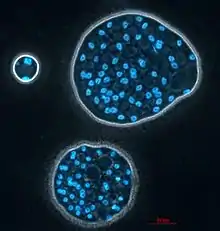Holozoa
Holozoa is a group of organisms that includes animals and their closest single-celled relatives, but excludes fungi.[1][2][3][4] Holozoa is also an old name for the tunicate genus Distaplia.[5]
| Holozoans | |
|---|---|
 | |
| Orange elephant ear sponge, Agelas clathrodes, in foreground. Two corals in the background: a sea fan, Iciligorgia schrammi, and a sea rod, Plexaurella nutans. | |
| Scientific classification | |
| (unranked): | Unikonta |
| (unranked): | Obazoa |
| (unranked): | Opisthokonta |
| (unranked): | Holozoa Lang et al., 2002 |
| Subgroups | |
| |
Because Holozoa is a clade including all organisms more closely related to animals than to fungi, some authors prefer it to recognizing paraphyletic groups such as Choanozoa, which mostly consists of Holozoa minus animals.[6]
Perhaps the best-known holozoans, apart from animals, are the choanoflagellates, which strongly resemble the collar cells of sponges, and so were theorized to be related to sponges even in the 19th century. Proterospongia is an example of a colonial choanoflagellate that may shed light on the origin of sponges.
The affinities of the other single-celled holozoans only began to be recognized in the 1990s.[7] The sub-classification Icthyosporea or Mesomycetozoea contains a number of mostly parasitic species. The amoeboid genera Ministeria and Capsaspora may be united in a group called Filasterea by the structure of their thread-like pseudopods. Along with choanoflagellates, filastereans may be closely related to animals, and one analysis grouped them together as the clade Filozoa.[3]
Phylogeny
The phylogenetic tree based on a 2011 multigene analysis is shown below. It is indicated how many million years ago (Mya) the clades diverged into newer clades.[8][9][10] The holomycota tree is following Tedersoo et al.[11]
| Opisthokonta |
| ||||||||||||||||||||||||||||||||||||||||||||||||||||||||||||||||||||||||||||||||||||
| 1300 mya |
The alternative hypothesis is the teretosporea clade.
References
- Aleshin, V.V. (December 2007). Konstantinova, A.V.; Mikhailov, K.V.; Nikitin, M.A.; Petrov, N.B. "Do we need many genes for phylogenetic inference?". Biochemistry Mosc. 72 (12): 1313–23. doi:10.1134/S000629790712005X. PMID 18205615. S2CID 12594007.
- Lang, B.F. (October 2002). O'Kelly, C., Nerad, T., Gray, M.W., Burger, G. "The closest unicellular relatives of animals". Current Biology. 12 (20): 1773–8. doi:10.1016/S0960-9822(02)01187-9. PMID 12401173. S2CID 14192333.
- Shalchian-Tabrizi, Kamran; Minge, Marianne A.; Espelund, Mari; Orr, Russell; Ruden, Torgeir; Jakobsen, Kjetill S.; Cavalier-Smith, Thomas; Aramayo, Rodolfo (7 May 2008). Aramayo, Rodolfo (ed.). "Multigene phylogeny of choanozoa and the origin of animals". PLOS ONE. 3 (5): e2098. Bibcode:2008PLoSO...3.2098S. doi:10.1371/journal.pone.0002098. PMC 2346548. PMID 18461162.
- Elias, M.; Archibald, J.M. (August 2009). "The RJL family of small GTPases is an ancient eukaryotic invention probably functionally associated with the flagellar apparatus". Gene. 442 (1–2): 63–72. doi:10.1016/j.gene.2009.04.011. PMID 19393304.
- Tatiàn, Marcos; Antacli, Julieta Maria; Sahade, Ricardo (2005). "Ascidians (Tunicata, Ascidiacea): species distribution along the Scotia Arc". Scientia Marina. 69 (suppl. 2): 205–214. doi:10.3989/scimar.2005.69s2205.
- Steenkamp, Emma T.; Wright, Jane; Baldauf, Sandra L. (January 2006). "The Protistan Origins of Animals and Fungi". Molecular Biology & Evolution. 23 (1): 93–106. doi:10.1093/molbev/msj011. PMID 16151185.
- Ragan, Mark A.; Goggin, C. Louise; Cawthorn, Richard J.; Cerenius, Lage; Jamieson, Angela V.C.; Plourde, Susan M.; Rand, Thomas G.; Söoderhäll, Kenneth; Gutell, Robin R. (15 October 1996). "A novel clade of protistan parasites near the animal-fungal divergence". PNAS. 93 (21): 11907–11912. Bibcode:1996PNAS...9311907R. doi:10.1073/pnas.93.21.11907. PMC 38157. PMID 8876236.
- Laura Wegener Parfrey; Daniel J G Lahr; Andrew H Knoll; Laura A Katz (16 August 2011). "Estimating the timing of early eukaryotic diversification with multigene molecular clocks" (PDF). Proceedings of the National Academy of Sciences of the United States of America. 108 (33): 13624–9. doi:10.1073/PNAS.1110633108. ISSN 0027-8424. PMC 3158185. PMID 21810989. Wikidata Q24614721.
- Torruella, Guifré; de Mendoza, Alex; Grau-Bové, Xavier; Antó, Meritxell; Chaplin, Mark A.; del Campo, Javier; Eme, Laura; Pérez-Cordón, Gregorio; Whipps, Christopher M. (21 September 2015). "Phylogenomics Reveals Convergent Evolution of Lifestyles in Close Relatives of Animals and Fungi". Current Biology. 25 (18): 2404–2410. doi:10.1016/j.cub.2015.07.053. ISSN 0960-9822. PMID 26365255.
- Hehenberger, Elisabeth; Tikhonenkov, Denis V.; Kolisko, Martin; Campo, Javier del; Esaulov, Anton S.; Mylnikov, Alexander P.; Keeling, Patrick J. (2017). "Novel Predators Reshape Holozoan Phylogeny and Reveal the Presence of a Two-Component Signaling System in the Ancestor of Animals". Current Biology. 27 (13): 2043–2050.e6. doi:10.1016/j.cub.2017.06.006. PMID 28648822.
- Tedersoo, Leho; Sánchez-Ramírez, Santiago; Kõljalg, Urmas; Bahram, Mohammad; Döring, Markus; Schigel, Dmitry; May, Tom; Ryberg, Martin; Abarenkov, Kessy (2018). "High-level classification of the Fungi and a tool for evolutionary ecological analyses". Fungal Diversity. 90 (1): 135–159. doi:10.1007/s13225-018-0401-0. ISSN 1560-2745.


